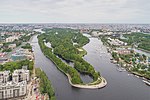Komendantsky Prospekt (Saint Petersburg Metro)
Railway stations in Russia opened in 2005Railway stations located underground in RussiaRussian railway station stubsRussian rapid transit stubsSaint Petersburg Metro stations

Komendantsky Prospekt (Russian: Комендантский проспект), literally translate - Avenue of Commendants ) is a station on the Frunzensko-Primorskaya Line of the Saint Petersburg Metro, opened on April 2, 2005. Its main decoration theme depicts the early years of Russian aviation, due to the location of the station at a former aviation field. It is the newest fourth metro station of the over-populated Primorsky district of Saint Petersburg, along with Pionerskaya and Chornaya Rechka stations of the Moskovsko-Petrogradskaya line and Staraya Derevnya of the Frunzensko-Primorskaya line.
Excerpt from the Wikipedia article Komendantsky Prospekt (Saint Petersburg Metro) (License: CC BY-SA 3.0, Authors, Images).Komendantsky Prospekt (Saint Petersburg Metro)
Комендантский проспект, Saint Petersburg Ozero Dolgoe (округ Озеро Долгое)
Geographical coordinates (GPS) Address Nearby Places Show on map
Geographical coordinates (GPS)
| Latitude | Longitude |
|---|---|
| N 60.009978 ° | E 30.256975 ° |
Address
Комендантский проспект
Комендантский проспект
197371 Saint Petersburg, Ozero Dolgoe (округ Озеро Долгое)
Saint Petersburg, Russia
Open on Google Maps









